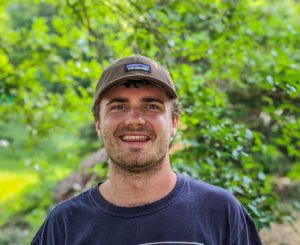
In the Fall of 2022, the Indiana University Prison Arts Initiative (IUPAI) was launched with a primary objective: to provide incarcerated individuals with the opportunity to receive college-level education. This innovative program aims to bridge the gap between correctional facilities and higher education, offering IU instructors and grad students the chance to teach courses within prisons. One of the initial courses offered by IUPAI was “Drawing Your Story: The Fundamentals of Drawing and Illustration.” Let’s take a closer look at how this groundbreaking initiative began.
Launching the IUPAI’s mission
In preparation for the initiative, Oliver Nell, MA in Art Administration (MAAA)’23 and IUPAI’s program coordinator, met with directors of comparable programs and individuals from the Department of Corrections for training. Even with these preparations, Nell admits the IUPAI team was not fully prepared.
Unexpected challenges can arise in a prison environment. Those facilitating the classes were forced to adapt and learn on the spot when they were physically present and engaging with the students.
“We added the facility training, but it’s once you get in there, and you’re teaching,” Nell said. “You can’t replicate it until you’re in the facility with the student, talking to them, learning from them. You are dealing with the things that come up in a prison and learning on the fly.”
Nell and the IUPAI team encountered more than just unexpected challenges. They gained valuable insights from the incarcerated students and realized the true worth of the program.
Discovering the privilege of creativity
Nell was aware of the demand for art in the prison system but did not anticipate how highly the classes would be esteemed by those attending.
“Once you’re actually teaching the classes, you realize the value that so many of us take for granted, like learning to draw or having a sketchbook—even having access to space to sit and think and be creative is a privilege.” Nell said. “Regular university students, they can’t wait to get out of class. The prison is the opposite. They can’t wait to be in class.”
“Art is therapeutic, and it’s expressive, and it puts a value on people’s identities and people’s stories.”
Students described it as an escape. This escape was a way for them to break free from the confines of prison and express themselves without judgment or fear of repercussions. It was a place where they could explore their creativity and find solace in their art.
The art class had a positive impact on the students’ confidence, as well. Many of them expressed increased self-assurance in their ideas and opinions. One aspect that resonated with the students was the class’s emphasis on their individuality and personal narratives, which are often overlooked in a prison environment.
Upon the conclusion of the course, students showcased their assignments and participated in a class critique and student survey. They expressed their gratitude for receiving positive feedback, something they rarely experience.
Why incarcerated individuals deserve access to higher education
Nell strongly believes in the transformative power of education and that everyone should have access to learning.
“We go to college, and we go to graduate school, we even go to high school because we know that knowledge is life– changing,” Nell said.
When examining the issue of ‘ who requires assistance the most,‘ it becomes apparent that the incarcerated are among the most disadvantaged populations due to their lack of access to knowledge, despite its transformative potential.
“There are, of course, plenty of populations in as much need but we felt like our local incarcerated populations were within our reach,” Nell said.
He acknowledges that, regrettably, incarcerated individuals are frequently disregarded.
“IU and all state universities are there to serve the people of their state,” Nell said. “Often incarcerated populations are overlooked, even though they are citizens.”
Conclusion
The IUPAI is a commendable outreach partnership that offers education and personal development opportunities to incarcerated individuals. Through collaboration and outreach, the initiative creates bridges between incarcerated individuals, faculty, and the community. With its continued growth and impact, IUPAI is making a significant difference in the lives of those within the prison system.
IUPAI’s objective and hope is to integrate prison education into IU’s endeavors.
“Our goals are to continue expanding and getting funding and making prison education more a part of what IU does,” Nell said.
To learn more about how IUPAI is impacting our local incarcerated communities go to: https://artsandhumanities.indiana.edu/cook-center/iupai/index.html
Leave a Reply